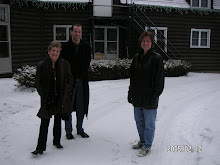Brian Seaman had graduated in 2002. In about 2004 we were chatting about the ill state of professional practices and how graduates just didn't get the "big picture" when it came to setting up an office.
It has always been my belief that a professional school, like chiropractic colleges, should teach students 3 fundamental things. First, how to diagnose a condition. Second, how to deal with a patient health problem. And third, how to create the environment in which those processes will take place. It does not matter how wonderful a diagnostician or practitioner a graduate might be -- if they are unable to create the office envirnment in which to carry out those functions they will be doomed to failure. This can come in many forms: not hiring proper staff; bad accounting methods; inappropriate leasing; over consumption of practice equipment etc. etc etc.
But lecturing has its limitations. Looking at drowsy faces at 8:00 am. on a Wednesday morning, there may have been a few students who were able to survive the two hours of diatribe even if it was mixed with ill humor, sarcasm, wit and words of "worlds ending and impending disasters".
During the conversation with Brian, we stumbled on the idea that the students should be required to "walk the walk" before stepping into the "real" world. This would be based upon the students being put into groups of between 4 to 6 students and being required to create a business plan involving anything from the establishing of an office; associating, purchasing a practice or any variation. The project would require that the students do a demographic study; lease or buy property; create an office design; cost out the leaseholds, equipment and office supplies; do a bank proposal including financial statements; create office policies and marketing; deal with insurance and patient documents. It truly was to be the creation of an office.
The first year of its use would be 1985. I was going to name it the "Seaman Project" but was a little concerned about the maturity of my students. I was then going to use Brian's initials, but I had even more concern about the title "BS Project", so it eventually became the Jurisprudence Project.
It just doesn't quiet down. When I thought I would get some time to do some more writing, I end up with a few more urgent issues. I just finished dealing with a judicial review application but more will be said of that when the decision is released in late August. The results were as expected and quite satisfactory, even though a little sad for the individual on the other side of the application.
Anyway, by the time I had taught my risk management course for a few years -- consideration was given to increasing the information that was to be taught to graduating students in the area of practice management. The course was being taught by a chiropractor, but was a little off the mark for what was necessary to establish a professional practice. This was not unusual since I knew of no professional school in Canada that was preparing professionals for anything other than their specific discipline. I graduated from law school with almost no knowledge relating to matters relating to practice. It was a matter of "trial by error".
In about 1980 or so, I was asked to co-teach a course in practice management and by 1982 I was left to start teaching both risk management and practice management. At its "height", I was teaching a third year course preparing the students for risk management issues in practice and a fourth year course in practice management. While it would have been easier just to provide the information myself, it was not a "legitimate" method of presenting information to the students.
As such, I cajoled, dragged in, begged, pleaded and coerced individuals to assist in the teaching of the course through guest lectures. From about 1982 until the completion of my teaching, the students had the privilege of having lectures given by the following individuals: Ernie Wolkin, Paul Carey, Greg Dunn, Jo-Ann Willson, Sil Mior, Jean Moss, Chris Paliare, Linda Rothstein, Ian Roland, Maureen McCandless, Doug Brown, Nick Tantalo, Harry James, Len Goodman, Don Nixdorf, and a further group of architects, accountants, bankers, and chiropractors.
These individuals who gave of their time and expertise to provide the students with invaluable information that very few people could afford to obtain on an hourly basis. I was never quite sure that the students understood or appreciated what they were receiving, but occassionaly years after graduation I would meet a student who would actually express appreciation for the depth of information that was being provided to them by these experts.
The information being given to the student through the lectures should have been enough. But a chance discussion with Dr. Brian Seaman, a 1982 graduate, of Halifax, Nova Scotia and a member of the Board of Governors of CMCC led to a new dimension in chiropractic education. An innovation that I have been proud of ever since.
Anyway, by the time I had taught my risk management course for a few years -- consideration was given to increasing the information that was to be taught to graduating students in the area of practice management. The course was being taught by a chiropractor, but was a little off the mark for what was necessary to establish a professional practice. This was not unusual since I knew of no professional school in Canada that was preparing professionals for anything other than their specific discipline. I graduated from law school with almost no knowledge relating to matters relating to practice. It was a matter of "trial by error".
In about 1980 or so, I was asked to co-teach a course in practice management and by 1982 I was left to start teaching both risk management and practice management. At its "height", I was teaching a third year course preparing the students for risk management issues in practice and a fourth year course in practice management. While it would have been easier just to provide the information myself, it was not a "legitimate" method of presenting information to the students.
As such, I cajoled, dragged in, begged, pleaded and coerced individuals to assist in the teaching of the course through guest lectures. From about 1982 until the completion of my teaching, the students had the privilege of having lectures given by the following individuals: Ernie Wolkin, Paul Carey, Greg Dunn, Jo-Ann Willson, Sil Mior, Jean Moss, Chris Paliare, Linda Rothstein, Ian Roland, Maureen McCandless, Doug Brown, Nick Tantalo, Harry James, Len Goodman, Don Nixdorf, and a further group of architects, accountants, bankers, and chiropractors.
These individuals who gave of their time and expertise to provide the students with invaluable information that very few people could afford to obtain on an hourly basis. I was never quite sure that the students understood or appreciated what they were receiving, but occassionaly years after graduation I would meet a student who would actually express appreciation for the depth of information that was being provided to them by these experts.
The information being given to the student through the lectures should have been enough. But a chance discussion with Dr. Brian Seaman, a 1982 graduate, of Halifax, Nova Scotia and a member of the Board of Governors of CMCC led to a new dimension in chiropractic education. An innovation that I have been proud of ever since.
It has been a couple of wild weeks which have involved dealing with Human Rights Complaints; privacy issues; judicial review applications and the usual amount of aggravation.
But back to history.
By the middle of start if the 80's I was teaching 2 hours a week for the entire school year. It was actually quite enjoyable because the students were deeply interested in knowing and being prepared for what was going on in the real world. The third year course prepared the students for clinic and the fourth year course was to provide information on the establishment and operation of a health care clinic.
The issues in chiropractic in my first ten years of being involved in the profession were interesting, entertaining and adventurous. I took great pleasure in fighting some of the battles which continued with respect to the attitude of hospitals, governments and other health care workers. I didn't appreciate chiropractors being referred to as "mr" and I appreciated even less the attitude of a hospital or medical doctor who thought that patient information was not going to be provided to a chiropractor, even with the consent of a patient. Pro Bono work dealing with such nonsense was rewarding.
I recall one incident in the late 70's; early 80's where a west end Toronto newspaper writer decided he would do an expose on chiropractic. It was worse than junk science with no factual information -- just basic nonsense about the educational background and training of chiropractors at CMCC. It was a two part series. I recalled the writer's name and so I did a little research. It turned out the writer had been a pharmacist who had run afoul of his licensing body and had his license revoked for fraud. My letter to the publisher gave a polite request for the writer to refrain from any further such reports or he could deal with the fallout of the lack of integrity of the writer. My language was a little bit more colourful, but in any event he must have gotten the message. We never heard from the writer on the issue again. As I said, those were interesting times.
But back to history.
By the middle of start if the 80's I was teaching 2 hours a week for the entire school year. It was actually quite enjoyable because the students were deeply interested in knowing and being prepared for what was going on in the real world. The third year course prepared the students for clinic and the fourth year course was to provide information on the establishment and operation of a health care clinic.
The issues in chiropractic in my first ten years of being involved in the profession were interesting, entertaining and adventurous. I took great pleasure in fighting some of the battles which continued with respect to the attitude of hospitals, governments and other health care workers. I didn't appreciate chiropractors being referred to as "mr" and I appreciated even less the attitude of a hospital or medical doctor who thought that patient information was not going to be provided to a chiropractor, even with the consent of a patient. Pro Bono work dealing with such nonsense was rewarding.
I recall one incident in the late 70's; early 80's where a west end Toronto newspaper writer decided he would do an expose on chiropractic. It was worse than junk science with no factual information -- just basic nonsense about the educational background and training of chiropractors at CMCC. It was a two part series. I recalled the writer's name and so I did a little research. It turned out the writer had been a pharmacist who had run afoul of his licensing body and had his license revoked for fraud. My letter to the publisher gave a polite request for the writer to refrain from any further such reports or he could deal with the fallout of the lack of integrity of the writer. My language was a little bit more colourful, but in any event he must have gotten the message. We never heard from the writer on the issue again. As I said, those were interesting times.
Subscribe to:
Posts (Atom)
























